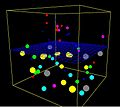Computer simulation
Computer simulation is a method in which a computer program models the behavior or appearance of a physical or abstract system. Computer simulations are used to explore and gain insight into new concepts, to test and verify theoretical models, and to simulate systems that are either too dangerous or impractical to experiment with in reality. The process involves the development of mathematical models that represent the key characteristics or behaviors of the selected system. These models are then coded into simulation software, which uses algorithms to simulate the evolution of the system over time.
Types of Computer Simulations[edit]
Computer simulations can be broadly categorized into two main types: continuous and discrete.
- Continuous simulations model systems in a continuous manner, using equations to describe the changes in the system over time. These are often used in engineering, physics, and environmental science.
- Discrete simulations, on the other hand, model systems in a stepwise manner, where changes occur at discrete points in time. This type is commonly used in computer science, operations research, and the study of complex systems.
Applications[edit]
Computer simulations have a wide range of applications across various fields:
- In Engineering, simulations are used for the design and testing of new products, such as vehicles, buildings, and electronics, to predict performance before physical prototypes are built.
- In Medicine, they assist in the development of new drugs, the modeling of biological systems, and the training of medical professionals through virtual surgeries.
- Climate Modeling uses simulations to predict changes in the climate and assess the impact of human activities on the environment.
- In Economics and Finance, simulations help in predicting market trends, assessing risks, and understanding the potential outcomes of economic policies.
- Education benefits from simulations by providing interactive learning experiences that are otherwise impossible or impractical in a traditional classroom setting.
Advantages and Limitations[edit]
The primary advantage of computer simulations is their ability to explore scenarios without the constraints of the real world, allowing for safer, more cost-effective, and faster analysis. However, the accuracy of a simulation is heavily dependent on the quality of the underlying model and the data used. Misinterpretation of results and overreliance on simulations can lead to incorrect conclusions.
Developing a Computer Simulation[edit]
The development of a computer simulation involves several key steps:
1. Defining the problem: Clearly identifying the system to be modeled and the objectives of the simulation. 2. Developing the model: Creating a mathematical representation of the system, which includes defining the variables and equations that describe the system's behavior. 3. Implementing the model: Coding the model into a computer program using simulation software. 4. Validation and verification: Ensuring the model accurately represents the real-world system and that the simulation behaves as expected. 5. Running simulations: Executing the simulation to study the behavior of the system under various conditions. 6. Analyzing results: Interpreting the data generated by the simulation to draw conclusions and make decisions.
Future Directions[edit]
As computing power continues to increase and simulation software becomes more sophisticated, the potential applications for computer simulations are expanding. Emerging technologies like artificial intelligence and machine learning are being integrated into simulations, enhancing their capabilities and accuracy. This evolution is opening new frontiers in research, design, and decision-making processes across all disciplines.
-
Computer simulation of Typhoon Mawar 2005
-
Molecular simulation process
-
Osmosis computer simulation
Ad. Transform your life with W8MD's Budget GLP-1 injections from $75


W8MD offers a medical weight loss program to lose weight in Philadelphia. Our physician-supervised medical weight loss provides:
- Weight loss injections in NYC (generic and brand names):
- Zepbound / Mounjaro, Wegovy / Ozempic, Saxenda
- Most insurances accepted or discounted self-pay rates. We will obtain insurance prior authorizations if needed.
- Generic GLP1 weight loss injections from $75 for the starting dose.
- Also offer prescription weight loss medications including Phentermine, Qsymia, Diethylpropion, Contrave etc.
NYC weight loss doctor appointmentsNYC weight loss doctor appointments
Start your NYC weight loss journey today at our NYC medical weight loss and Philadelphia medical weight loss clinics.
- Call 718-946-5500 to lose weight in NYC or for medical weight loss in Philadelphia 215-676-2334.
- Tags:NYC medical weight loss, Philadelphia lose weight Zepbound NYC, Budget GLP1 weight loss injections, Wegovy Philadelphia, Wegovy NYC, Philadelphia medical weight loss, Brookly weight loss and Wegovy NYC
|
WikiMD's Wellness Encyclopedia |
| Let Food Be Thy Medicine Medicine Thy Food - Hippocrates |
Medical Disclaimer: WikiMD is not a substitute for professional medical advice. The information on WikiMD is provided as an information resource only, may be incorrect, outdated or misleading, and is not to be used or relied on for any diagnostic or treatment purposes. Please consult your health care provider before making any healthcare decisions or for guidance about a specific medical condition. WikiMD expressly disclaims responsibility, and shall have no liability, for any damages, loss, injury, or liability whatsoever suffered as a result of your reliance on the information contained in this site. By visiting this site you agree to the foregoing terms and conditions, which may from time to time be changed or supplemented by WikiMD. If you do not agree to the foregoing terms and conditions, you should not enter or use this site. See full disclaimer.
Credits:Most images are courtesy of Wikimedia commons, and templates, categories Wikipedia, licensed under CC BY SA or similar.
Translate this page: - East Asian
中文,
日本,
한국어,
South Asian
हिन्दी,
தமிழ்,
తెలుగు,
Urdu,
ಕನ್ನಡ,
Southeast Asian
Indonesian,
Vietnamese,
Thai,
မြန်မာဘာသာ,
বাংলা
European
español,
Deutsch,
français,
Greek,
português do Brasil,
polski,
română,
русский,
Nederlands,
norsk,
svenska,
suomi,
Italian
Middle Eastern & African
عربى,
Turkish,
Persian,
Hebrew,
Afrikaans,
isiZulu,
Kiswahili,
Other
Bulgarian,
Hungarian,
Czech,
Swedish,
മലയാളം,
मराठी,
ਪੰਜਾਬੀ,
ગુજરાતી,
Portuguese,
Ukrainian



